Cell signaling
1/27
There's no tags or description
Looks like no tags are added yet.
Name | Mastery | Learn | Test | Matching | Spaced |
|---|
No study sessions yet.
28 Terms
What is contact-dependent signaling
signal remains attached to cell surface receptor of the signaling cell and influences only those cells it contracts (NOT RELEASED)
What is paracrine signaling
signals (local mediators) are released but affect only targets in the vicinity
What is synaptic signaling
nervous system neurons with long axons that release chemical neurotransmitters onto post-synaptic sites
What is endocrine signaling
hormonal system cells synthesize and release chemical (protein, steroid, amine-derived) hormones into bloodstream to affect distant targets
What are autocrine signals
cells produces signals that they respond to themselves
Cancer cells
What are signal integration ion-channels
What are effector proteins
gene regulatory proteins, enzymes, ion channel proteins, parts of a metabolic pathway, or cytoskeletal proteins
What is the basic principle of cellular communication
Reception of signal depends on receptor proteins on cell surface or within cell or on cell nuclear membrane
Binding of signal activates receptor, then signal pathway is activated
Intracellular signaling proteins process signals, then effector proteins target changes in cell behavior
Effector proteins
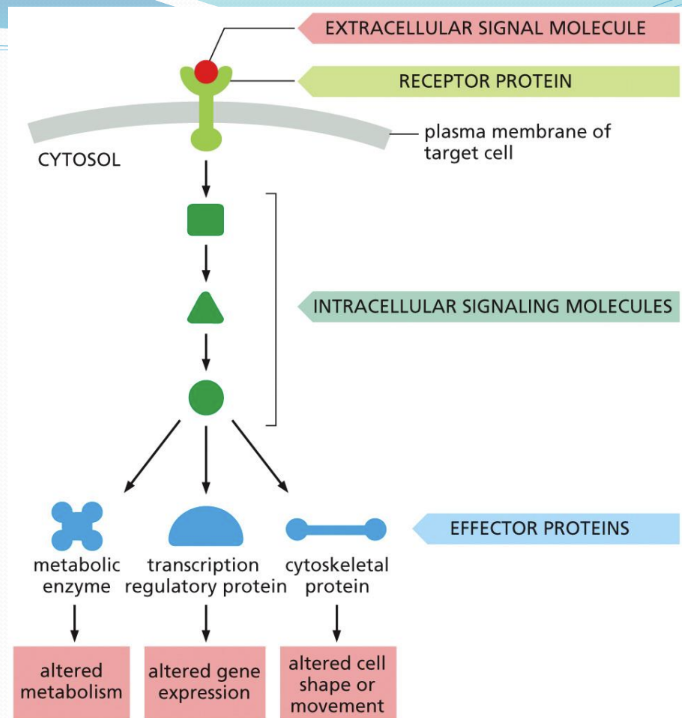
What is signal integration
Signal integration = cells must integrate and respond to multiple signals to provide the appropriate action at the appropriate time
No signal, no receptor => cell death likely
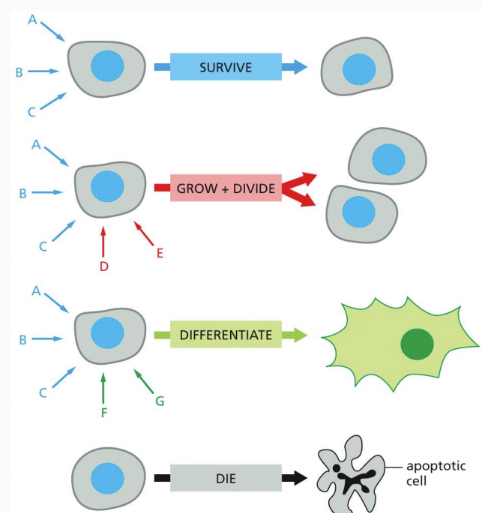
What are intracellular signaling proteins
once a cell membrane receptor has bound an extracellular signal, a second messenger is sent within the cell
Second messenger signals like cAMP and calcium or diacylglycerol pass along the signal to effectors
Effectors = molecular switches (on and off properties)
Include GTP binding, phosphorylation via kinases, removal of phosphate by phosphatases, altered protein conformation
Changes must be reversible or an over-action will occur
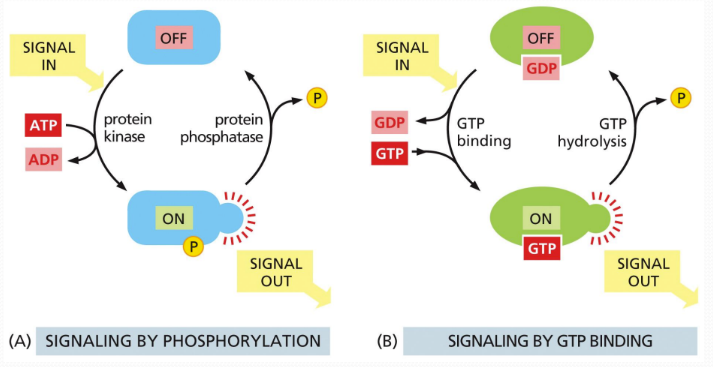
What are extracellular signal molecules & the 3 different types
Extracellular signal molecules = mediate communication between cells
Extracellular signals = membrane bound molecules or signals released into extracellular space by exocytosis or diffusion into extracellular space
Bind specific receptors on cell surface (transmembrane proteins) or other places in a cell
Ex: proteins, amino acids, steroids/hormones, & nitric oxide
types:
contact dependent signaling
paracrine signaling
long range signalers
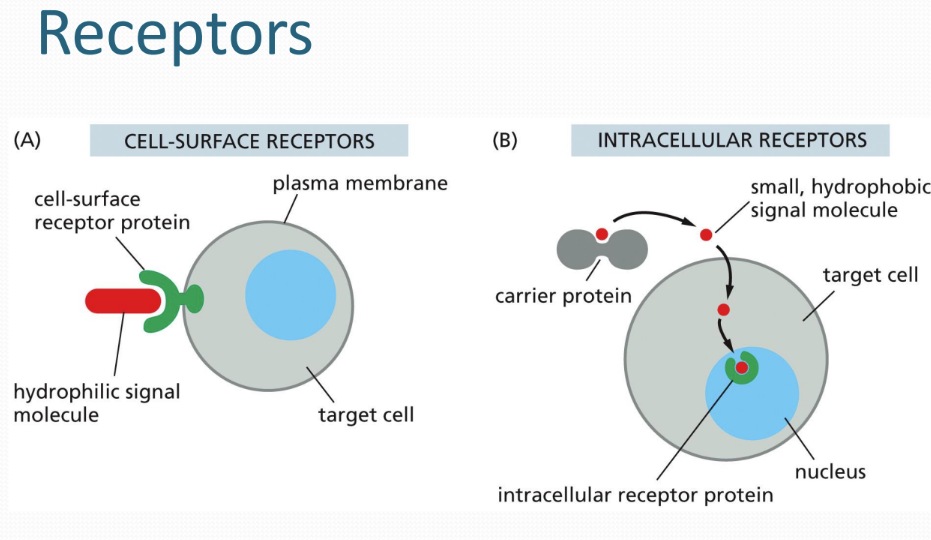
What is contact dependent signaling
Contact dependent signaling = signal remains attached to cell surface receptor of the signaling cell and influences only those cells it contacts
Important during development and immune response
Direct contact
type of extracellular signaling
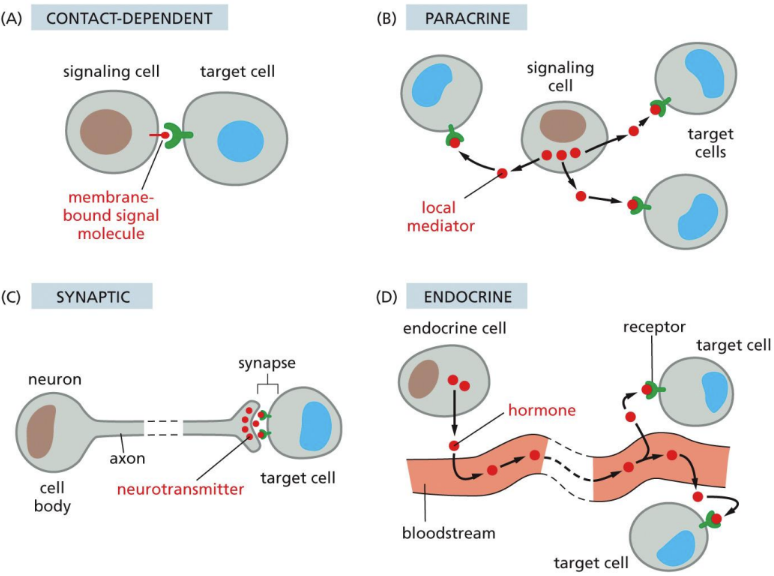
What is paracrine signaling
signals (local mediators) are released but affect only targets in the vicinity
Signaling cells and targets are different types of cells
Autocrine signals (cancer cells)
1 cell releases signal, nearby cell detects
type of extracellular signaling
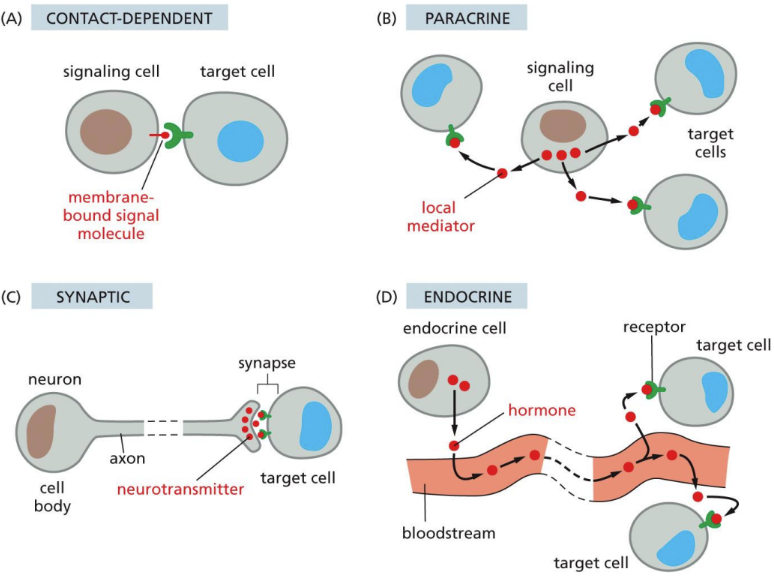
What is long range signalers? describe both types
Synaptic = nervous system neurons with long axons that release chemical neurotransmitters onto post-synaptic sites (synapse is the locale of release)
These sites then have an electrical reaction (action potential) based upon the type of neurotransmitter binding to the post-synaptic receptors
Target cell in neurons
Endocrine = hormonal system cells synthesize and release chemical (protein, steroid, amine-derived) hormones into bloodstream to affect distant targets
Releasing molecules into the bloodstream
type of extracellular signaling
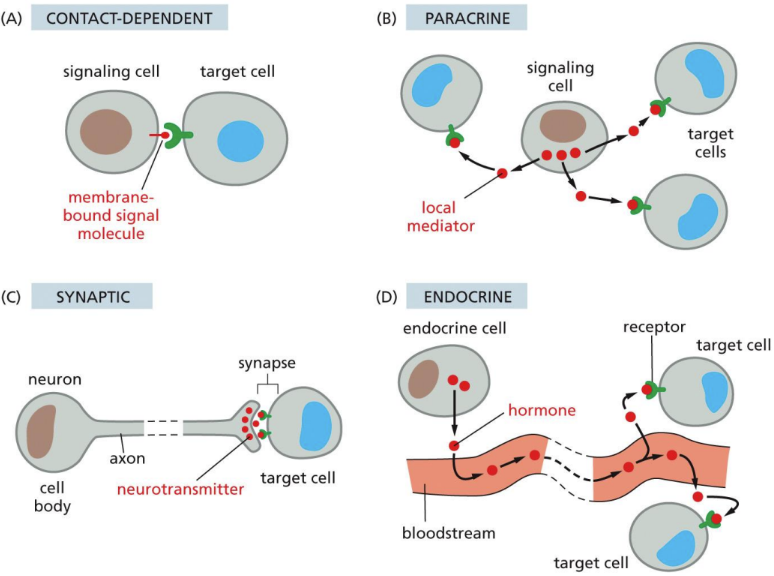
What are the types of responses a cell can have to a signal
Cellular response = different cell types respond to the same signal differently
Dependent on internal signals, effectors, and genes
Ex responses:
Decreased firing rate
Secretion
Muscle contraction
Response to extracellular signal = can be fast or slow, depends on mechanism of delivery, nature of response and turnover of signals
Fast response = if changes occur to proteins already present within cell (less than a sec. to mins)
altered protein function
Slow response = if changes to gene expression or new protein synthesis are required (mins to hrs.)
altered protein synthesis
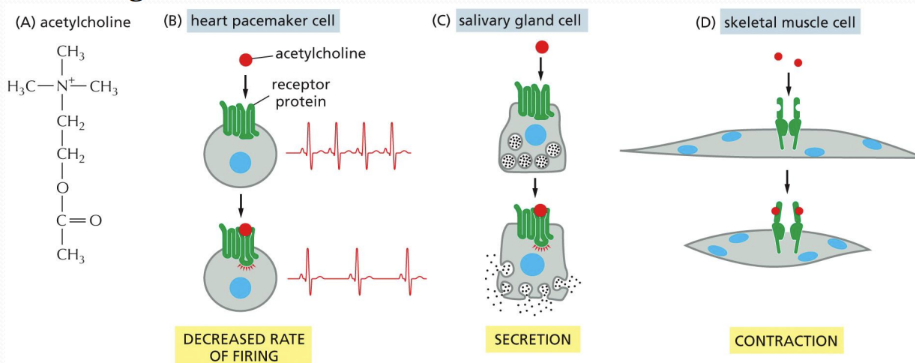
What are the 3 classes of cell-surface receptors
ion-channel coupled
GPCR
Enzyme coupled receptors
What is Ion-channel coupled receptors (ionotropic/transmitter-gated)
Ion-channel coupled (ionotropic/transmitter-gated) = rapid signals mediated by neurotransmitters that open or close ion channels based on excitation or inhibition of the post-synaptic target
Transmit signal fast
Ex: ion channel is coupled to a transmembrane protein
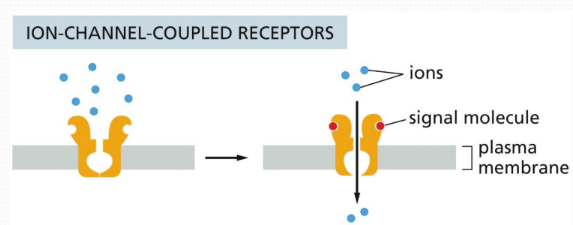
What are G-protein-coupled receptors (GPCR)
G-protein-coupled receptors (GPCR) = signal activates receptor and GTP-binding protein (G-protein) which in turn activates the target
Targets can be enzymes, other proteins, ion channels
G-protein subunit attaches to cytosolic lipid bilayer with an anchor

What are enzyme-coupled receptors
Enzyme-coupled receptors = can act as enzymes themselves once activated or associate and activate with enzymes intracellularly

What is a second messenger system
Delayed response to steroid hormone
One of the ways to respond to hormones
2 step process
A primary response protein shuts-off primary response gene
A primary response protein turns on secondary-response genes
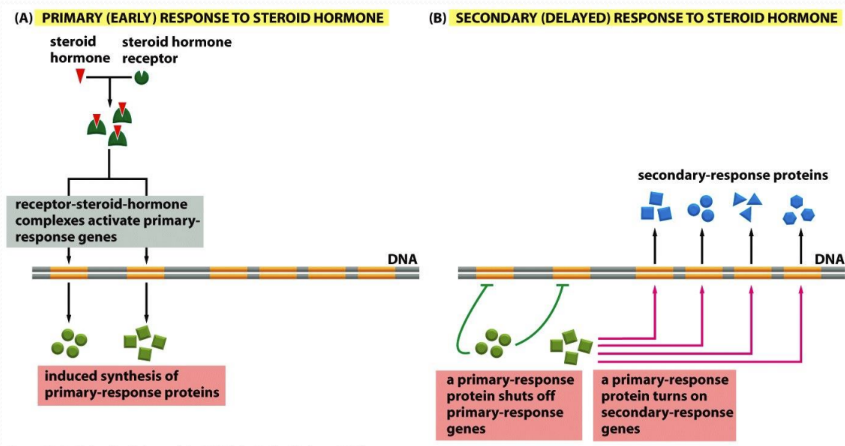
What are types of cellular responses
second messenger systems
phosphorylation
extracellular signal responses;
What is phosphorylation
Reaction in which a phosphate group is covalently coupled to another molecule
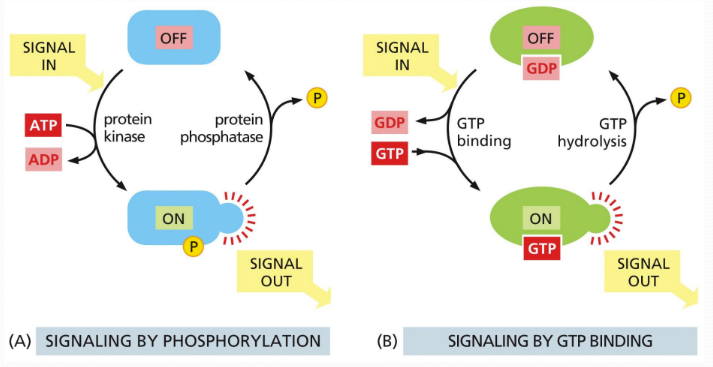
What are nuclear receptors
Nuclear receptors = hydrophobic signal molecules that move directly across the cell membrane and bind to intracellular receptor proteins (which then control transcription)
Steroid hormones, fat soluble vitamins, thyroid hormones
Belong to a superfamily
Transcriptional responses takes multiple steps
What are GPCR proteins
used by all eukaryotes (largest family of cell surface receptors)
Broad variety of function in sensation, neurotransmission, endocrine system, cell communication, drug and external world signaling
All GPCRs have a similar structure: polypeptide with several transmembrane domains and all use G proteins to signal cell interior
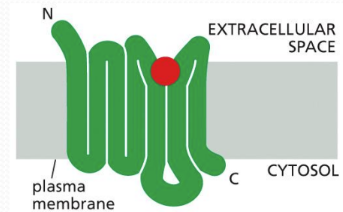
What are G proteins & their structure
trimeric GTP-binding proteins attached to cytoplasmic (inside the cell) face of cell membrane
Couples the receptor to either enzymes or ion channels
When signal binds to GPCR, the receptor activates the G protein
G proteins are specific for sets of GPCRs and a particular set of target proteins
Bind targets when activated that include enzymes or ion channels (activated of enzymes)
Considered to be stimulatory or inhibitory based on the activation of adenylyl cyclase (increases cAMP) or inhibition (decreases cAMP) of it
Adenylyl cyclase synthesizes cAMP which is how some extracellular signals work to mediate a cellular response
cAMP controls thyroid hormones, bone resorption, glycogen breakdown, & cortisol secretion
Structure = composed of 3 subunits: α, β, & y
α (a GTPase) binds GDP and keeps G protein inactive but then releases GDP and binds GTP which activates G protein
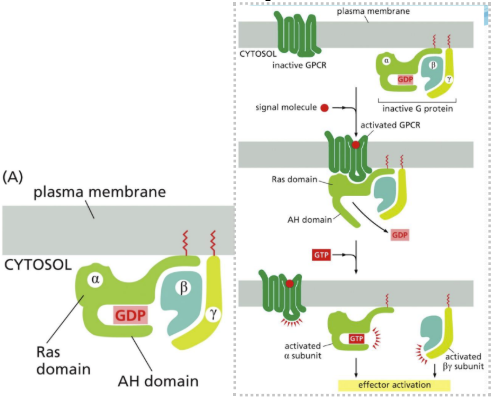
How does G protein activation work
Structure = composed of 3 subunits: α, β, & y
α (a GTPase) binds GDP and keeps G protein inactive but then releases GDP and binds GTP which activates G protein
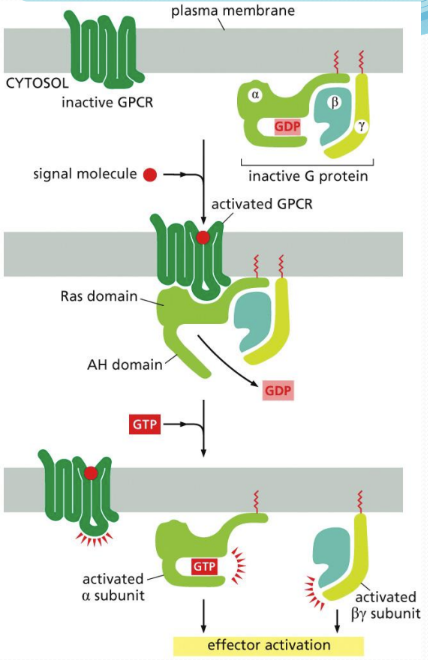
What are common causes in cell communication that lead to disease
Signals are lost
Diabetes type 1
Loss of immune protection
Cell signal does not reach target
Multiple sclerosis
Target cell does not respond
Diabetes type 2
Too much signal
Stroke with release of glutamate in brain
How does cell communication errors lead to cancer
Cancer = cell growth and division continues despite the absence of signal and loss of self-destruction, allowing for new signals to promote angiogenesis
Dysregulation of leukocyte adhesion and endothelial cell interaction contribute to the cancer (and vascular occlusion in sickle cell/sepsis)